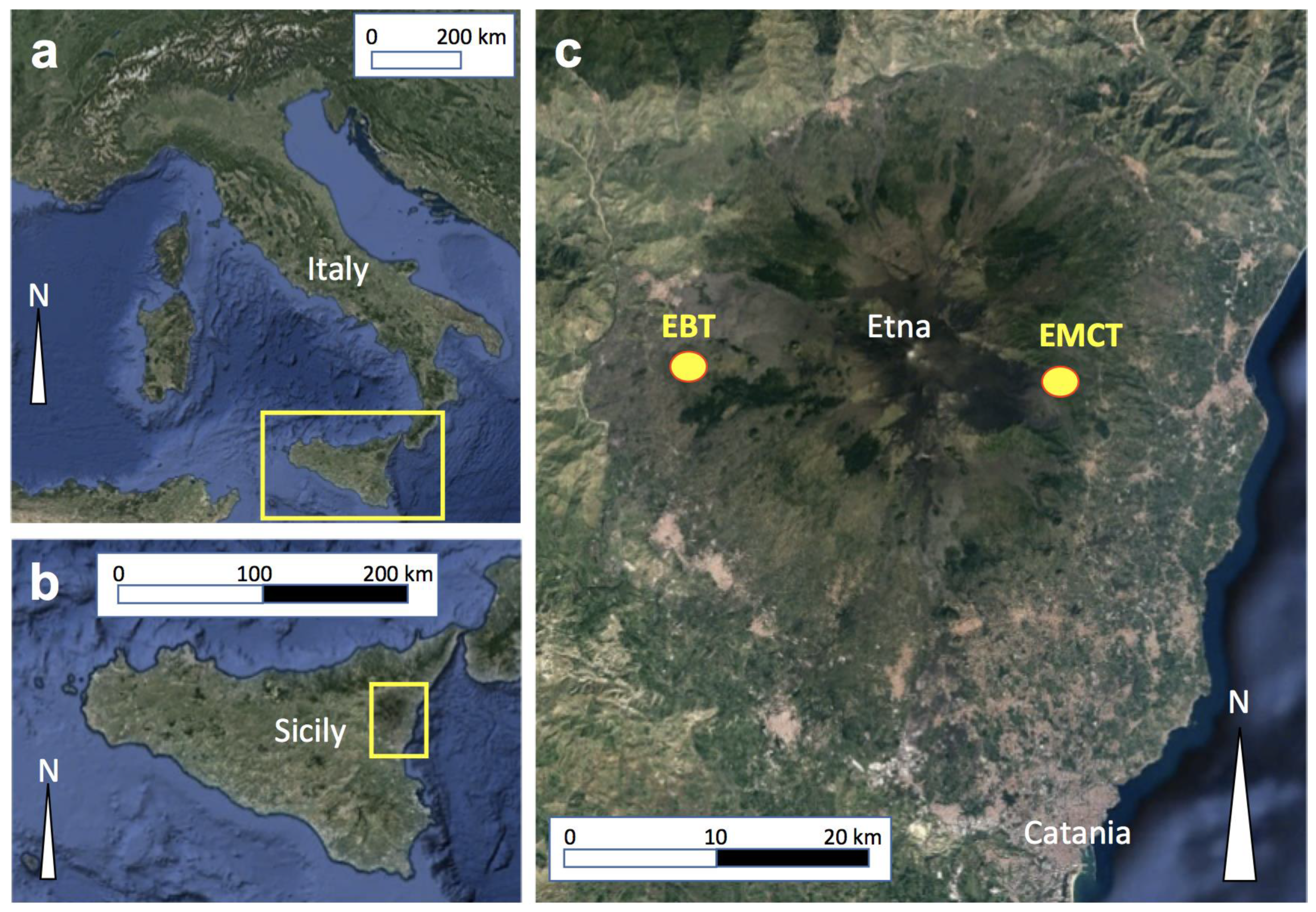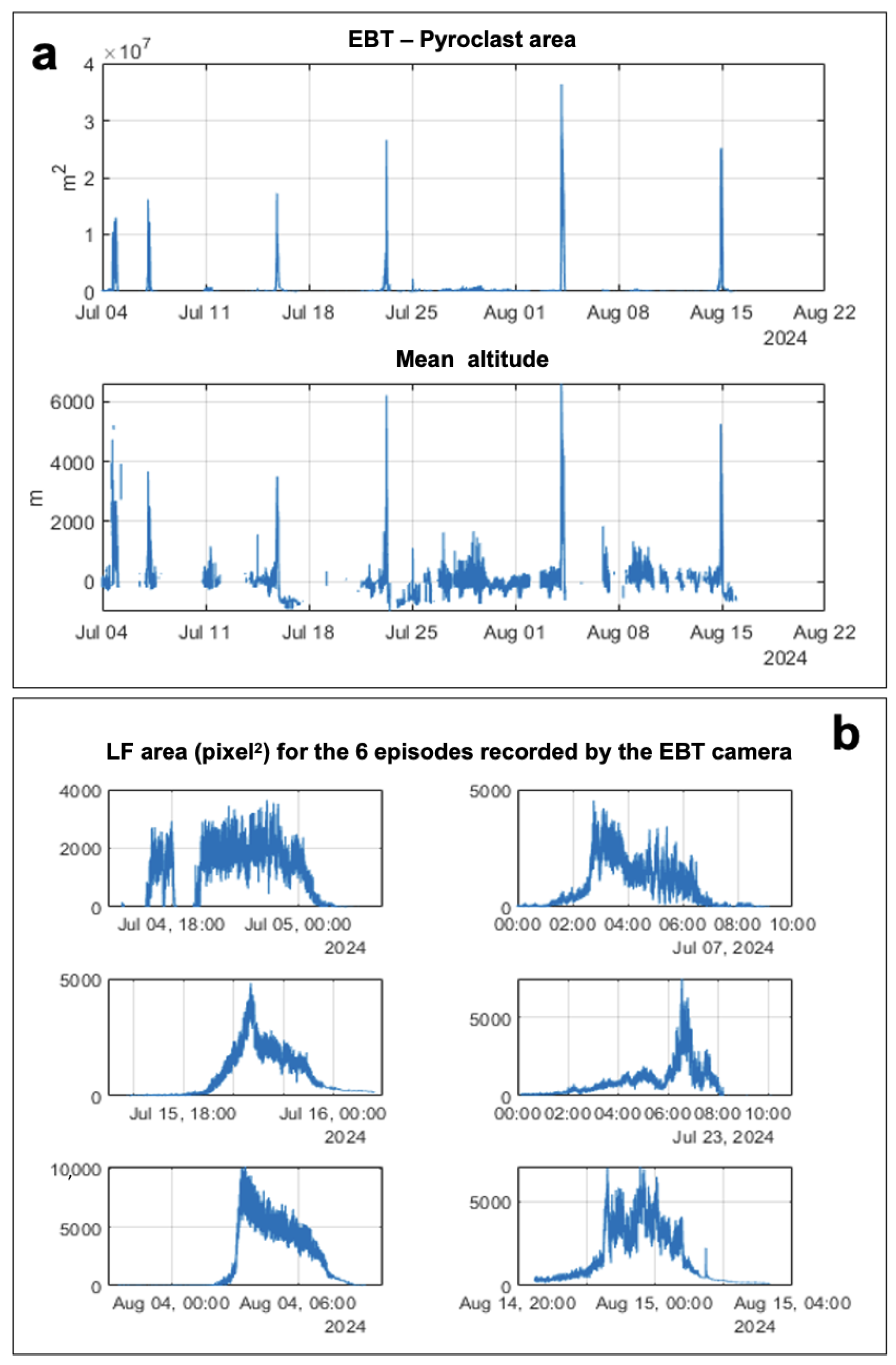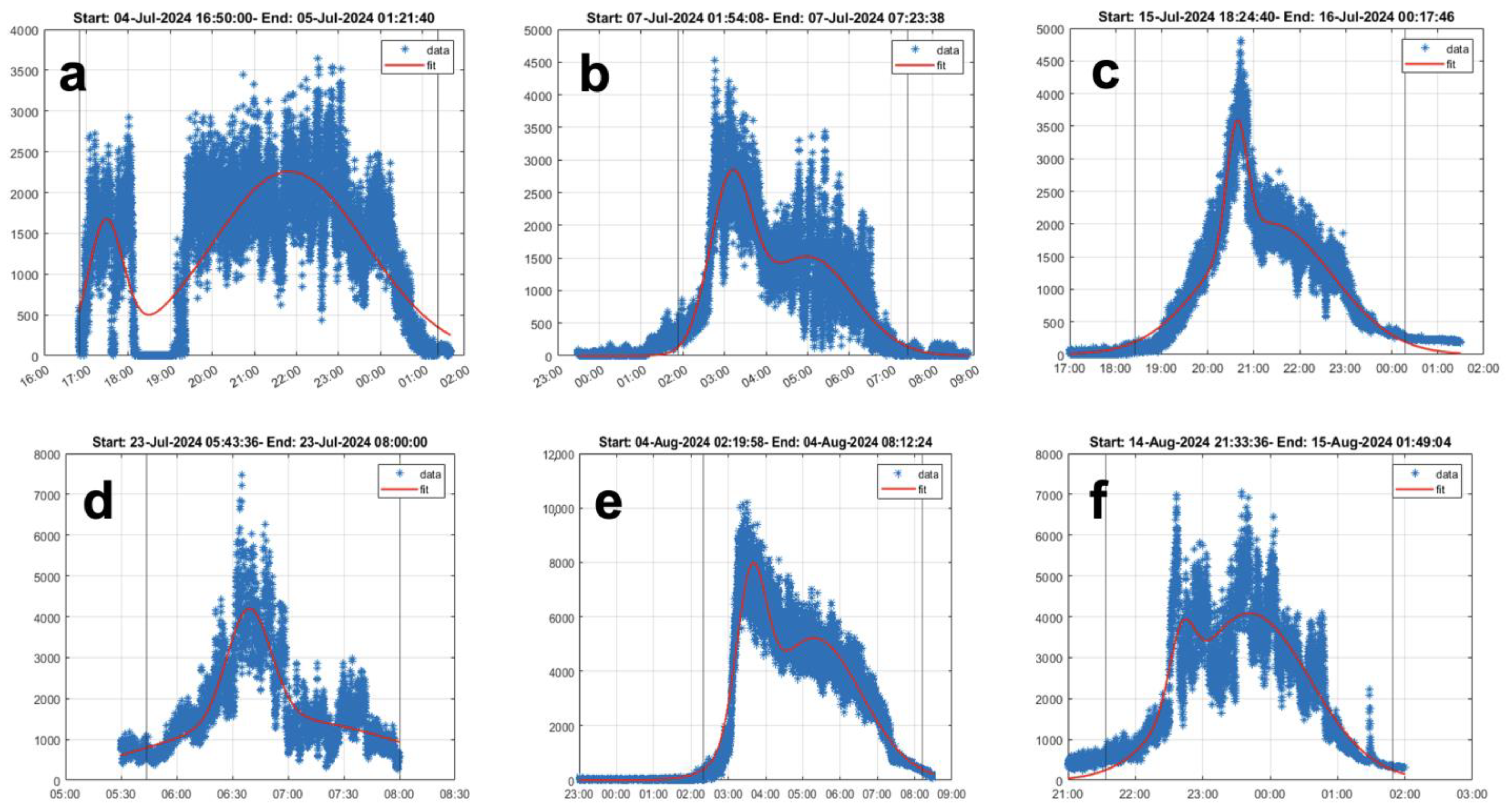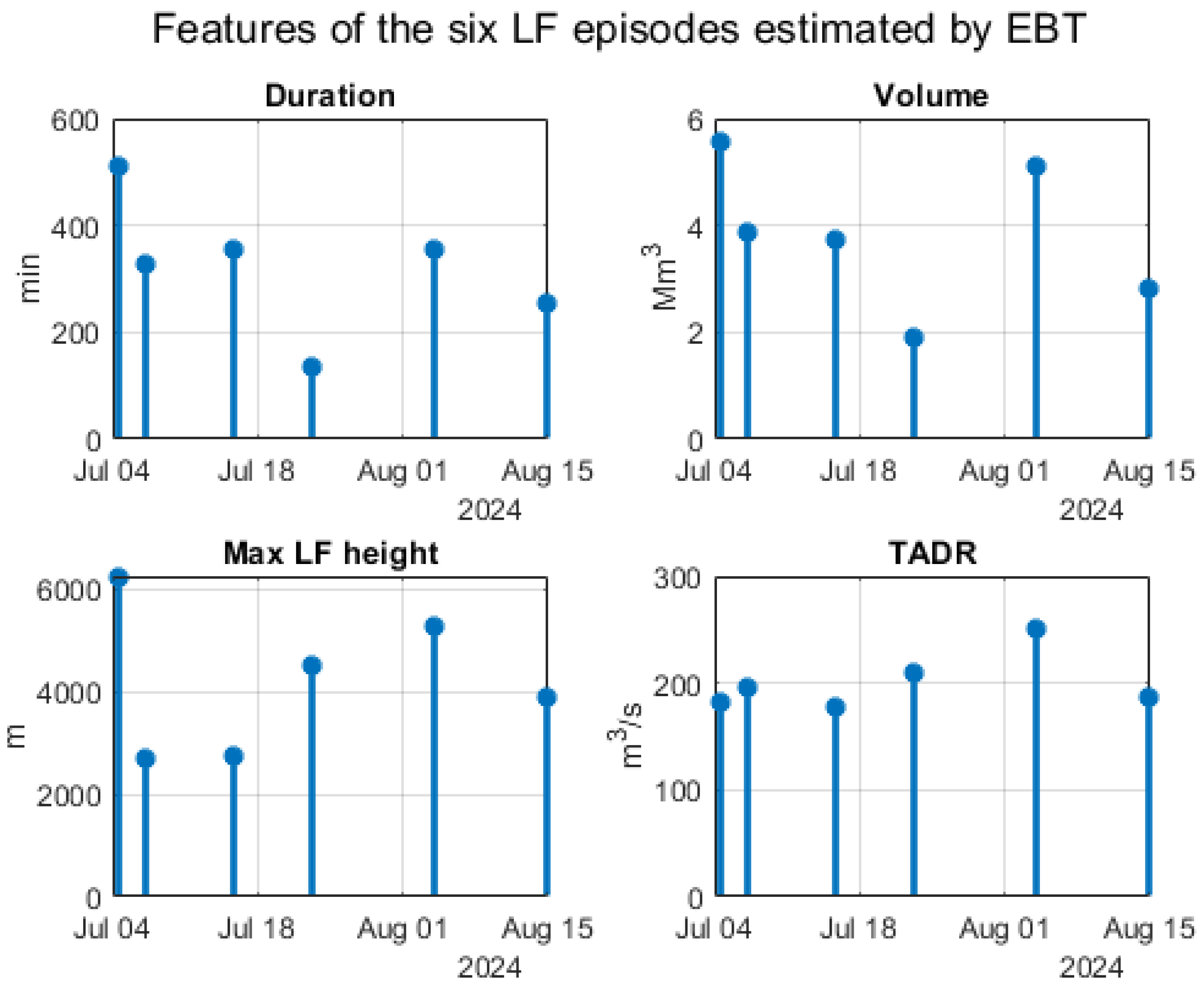Reawakening of Voragine, the Oldest of Etna’s Summit Craters: Insights from a Recurrent Episodic Eruptive Behavior
Abstract
:1. Introduction
2. Voragine (VOR) Eruptive Activity in 2024
3. Materials and Methods
The Software Package
- Area: the total number of pixels in the region, returned as a scalar.
- Centroid: the center of mass of the region, returned as a 1-by-Q vector. The first element of the centroid is the x-coordinate, and the second is the y-coordinate. Additional elements, if any, are ordered by dimension.
- Perimeter: the distance around the boundary of the region, returned as a scalar.
- Extract RGB frames from the original .avi files at each time step.
- Convert the RGB images to grayscale images.
- Crop the grayscale images to remove information bars (e.g., color bar, camera name and time stamp).
- Binarize the cropped grayscale images using an appropriate threshold level (ranging between 0.6 and 0.7). In these images, hot areas appear white, while the rest appears black.
- Apply a mask to filter out unwanted hot objects (e.g., cooling matter, vegetation).
- Measure the binarized and masked images to extract the desired information, resulting in the so-called labeled images.
4. Results
5. Discussion
6. Conclusive Remarks
Author Contributions
Funding
Data Availability Statement
Acknowledgments
Conflicts of Interest
List of the Acronyms Used in This Paper
| a.s.l. | above sea level |
| b.s.l. | below sea level |
| BN | Bocca Nuova crater |
| E | east |
| EBT | Etna, Bronte thermal |
| EMCT | Etna, Monte Cagliato thermal |
| INGV–OE | Istituto Nazionale di Geofisica e Vulcanologia, Osservatorio Etneo |
| LF | lava fountain |
| NEC | North-East Crater |
| NW | north-west |
| RGB | red, green and blue |
| ROI | region of interest |
| SE | south-east |
| SEC | South-East Crater |
| SSE | south-south-east |
| SSW | south-south-west |
| TADR | time-averaged discharge rate |
| UTC | Coordinated Universal Time |
| VOR | Voragine crater W = west |
References
- Mangan, M.; Cashman, K.; Swanson, D. The dynamics of Hawaiian-style eruptions: A century of study. In Characteristics of Hawaiian Volcanoes; USGS Professional Paper; Poland, M., Takahashi, T., Landowski, C., Eds.; US Geological Survey: Reston, VA, USA, 2014; Volume 1801, pp. 323–356. [Google Scholar]
- Calvari, S.; Cannavò, F.; Bonaccorso, A.; Spampinato, L.; Pellegrino, A.G. Paroxysmal Explosions, Lava Fountains and Ash Plumes at Etna Volcano: Eruptive Processes and Hazard Implications. Front. Earth Sci. 2018, 6, 107. [Google Scholar] [CrossRef]
- Calvari, S.; Bilotta, G.; Bonaccorso, A.; Caltabiano, T.; Cappello, A.; Corradino, C.; Del Negro, C.; Ganci, G.; Neri, M.; Pecora, E.; et al. The VEI 2 Christmas 2018 Etna Eruption: A Small But Intense Eruptive Event or the Starting Phase of a Larger One? Remote Sens. 2020, 12, 905. [Google Scholar] [CrossRef]
- Witt, T.; Walter, T.R.; Müller, D.; Guðmundsson, M.T.; Schöpa, A. The Relationship Between Lava Fountaining and Vent Morphology for the 2014–2015 Holuhraun Eruption, Iceland, Analyzed by Video Monitoring and Topographic Mapping. Front. Earth Sci. 2018, 6, 235. [Google Scholar] [CrossRef]
- Neal, C.A.; Brantley, S.R.; Antolik, L.; Babb, J.L.; Burgess, M.; Calles, K.; Cappos, M.; Chang, J.C.; Conway, S.; Desmither, L.; et al. The 2018 rift eruption and summit collapse of Kīlauea Volcano. Science 2019, 363, 367–374. [Google Scholar] [CrossRef]
- Andronico, D.; Cannata, A.; Di Grazia, G.; Ferrari, F. The 1986–2021 paroxysmal episodes at the summit craters of Mt. Etna: Insights into volcano dynamics and hazard. Earth-Sci. Rev. 2021, 220, 103686. [Google Scholar] [CrossRef]
- Wilson, L.; Head, J.W., III. Ascent and Eruption of Basaltic Magma on the Earth and Moon. J. Geophys. Res. 1981, 86, 2971–3001. [Google Scholar] [CrossRef]
- Jaupart, C.; Vergniolle, S. The generation and collapse of a foam layer at the roof of a basaltic magma chamber. J. Fluid Mech. 1989, 203, 347–380. [Google Scholar] [CrossRef]
- Vergniolle, S.; Jaupart, C. The dynamics of degassing at Kilauea volcano. Hawaii. J. Geophys. Res. 1990, 95, 2793–2809. [Google Scholar] [CrossRef]
- Parfitt, E.A.; Wilson, L. Explosive volcanic eruptions-IX. The transition between Hawaiian-style lava fountaining and Strombolian explosive activity. Geophys. J. Int. 1995, 121, 226–232. [Google Scholar] [CrossRef]
- Head, J.W.; Wilson, L. Lava fountain heights at Pu’u ‘O’o, Kilauea, Hawaii: Indicators of amount and variations of exsolved magma volatiles. J. Geophys. Res. Solid. Earth 1987, 92, 13715–13719. [Google Scholar] [CrossRef]
- Parfitt, E.; Wilson, L.; Neal, C. Factors influencing the height of Hawaiian lava fountains: Implications for the use of fountain height as an indicator of magma gas content. Bull. Volcanol. 1995, 57, 440–450. [Google Scholar] [CrossRef]
- Spampinato, L.; Calvari, S.; Oppenheimer, C.; Lodato, L. Shallow magma transport for the 2002-03 Mt. Etna eruption inferred from thermal infrared surveys. J. Volcanol. Geotherm. Res. 2008, 177, 301–312. [Google Scholar] [CrossRef]
- Heliker, C.; Mattox, T.N. The First Two Decades of the Pu’u ‘O’o-Kupaianaha Eruption: Chronology and Selected Bibliography; U.S. Geological Survey Professional Paper; US Geological Survey: Reston, VA, USA, 2003; Volume 1676, pp. 1–27. [Google Scholar]
- Privitera, E.; Sgroi, T.; Gresta, S. Statistical analysis of intermittent volcanic tremor associated with the September 1989 summit explosive eruptions at Mount Etna, Sicily. J Volcanol Geotherm Res 2003, 120, 235–247. [Google Scholar] [CrossRef]
- Eibl, E.P.S.; Thordarson, T.; Höskuldsson, Á.; Gudnason, E.Á.; Dietrich, T.; Hersir, G.P.; Ágústsdóttir, T. Evolving shallow conduit revealed by tremor and vent activity observations during episodic lava fountaining of the 2021 Geldingadalir eruption, Iceland. Bull. Volcanol. 2023, 85, 10. [Google Scholar] [CrossRef]
- Swanson, D.A.; Duffield, W.A.; Jackson, D.B.; Peterson, D.W. Chronological Narrative of the 1969-71 Mauna Ulu Eruption of Kilauea Volcano, Hawaii; United States Department of the Interior, Gwological Survey: Washington, DC, USA, 1979; Volume 1056, p. 55, U.S Geol Surv Prof Paper. [Google Scholar]
- Wolfe, E.W.; Neal, C.A.; Banks, N.G.; Duggan, T.J. Geologic Observations and Chronology of Eruptive Events; 1988; Volume 1463, pp. 1–98, USGS Prof. Paper. [Google Scholar]
- Heliker, C.; Wright, T.J. The Pu’u ‘O’o-Kupaianaha Eruption of Kilauea. EOS Trans. Am. Geophys. Union. 1991, 72, 521–536. [Google Scholar] [CrossRef]
- Calvari, S.; Nunnari, G. Etna Output Rate during the Last Decade (2011–2022): Insights for Hazard Assessment. Remote Sens. 2022, 14, 6183. [Google Scholar] [CrossRef]
- Calvari, S.; Salerno, G.G.; Spampinato, L.; Gouhier, M.; La Spina, A.; Pecora, E.; Harris, A.J.L.; Labazuy, P.; Biale, E.; Boschi, E. An unloading foam model to constrain Etna’s 11–13 January 2011 lava fountaining episode. J. Geophys. Res. 2011, 116, B11207. [Google Scholar] [CrossRef]
- Calvari, S.; Pinkerton, H. Instabilities in the summit region of Mount Etna during the 1999 eruption. Bull. Volcanol. 2001, 63, 526–535. [Google Scholar] [CrossRef]
- Behncke, B.; Neri, M.; Carniel, R. An exceptional case of endogenous lava dome growth spawning pyroclastic avalanches: The 1999 Bocca Nuova eruption of Mt. Etna (Italy). J. Volcanol. Geotherm. Res. 2003, 124, 115–128. [Google Scholar] [CrossRef]
- Andronico, D.; Cristaldi, A.; Scollo, S. The 4–5 September 2007 lava fountain at South-East Crater of Mt Etna, Italy. J. Volcanol. Geotherm. Res. 2008, 173, 325–328. [Google Scholar] [CrossRef]
- Andronico, D.; Branca, S.; Calvari, S.; Burton, M.R.; Caltabiano, T.; Corsaro, R.A.; Del Carlo, P.; Garfì, G.; Lodato, L.; Miraglia, L.; et al. A multi-disciplinary study of the 2002-03 Etna eruption: Insights for a complex plumbing system. Bull. Volc. 2005, 67, 314–330. [Google Scholar] [CrossRef]
- Di Traglia, F.; Battaglia, M.; Nolesini, T.; Lagomarsino, D.; Casagli, N. Shifts in the eruptive styles at Stromboli in 2010–2014 revealed by ground-based InSAR data. Sci. Rep. 2015, 5, srep13569. [Google Scholar] [CrossRef]
- Giordano, G.; De Astis, G. The summer 2019 basaltic Vulcanian eruptions (paroxysms) of Stromboli. Bull. Volcanol. 2020, 83, 1. [Google Scholar] [CrossRef]
- Calvari, S.; Di Traglia, F.; Ganci, G.; Bruno, V.; Ciancitto, F.; Di Lieto, B.; Gambino, S.; Garcia, A.; Giudicepietro, F.; Inguaggiato, S.; et al. Multi-parametric study of an eruptive phase comprising unrest, major explosions, crater failure, pyroclastic density currents and lava flows: Stromboli volcano, 1 December 2002–30 June 2021. Front. Earth Sci. 2022, 10, 899635. [Google Scholar] [CrossRef]
- Witt, T.; Walter, T.R. Video monitoring reveals pulsating vents and propagation path of fissure eruption during the March 2011 Pu’u ‘Ō’ō eruption, Kilauea volcano. J. Volcanol. Geotherm. Res. 2017, 330, 43–55. [Google Scholar] [CrossRef]
- Bonaccorso, A.; Calvari, S. Major effusive eruptions and recent lava fountains: Balance between expected and erupted magma volumes at Etna volcano. Geophys. Res. Lett. 2013, 40, 6069–6073. [Google Scholar] [CrossRef]
- Viccaro, M.; Giuffrida, M.; Zuccarello, F.; Scandura, M.; Palano, M.; Gresta, S. Violent paroxysmal activity drives self-feeding magma replenishment at Mt. Etna. Sci. Rep. 2019, 9, 6717. [Google Scholar] [CrossRef]
- Poret, M.; Corradini, S.; Merucci, L.; Costa, A.; Andronico, D.; Montopoli, M.; Vulpiani, G.; Freret-Lorgeril, V. Reconstructing volcanic plume evolution integrating satellite and ground-based data: Application to the 23 November 2013 Etna eruption. Atmos. Chem. Phys. 2018, 18, 4695–4714. [Google Scholar] [CrossRef]
- Scollo, S.; Prestifilippo, M.; Bonadonna, C.; Cioni, R.; Corradini, S.; Degruyter, W.; Rossi, E.; Silvestri, M.; Biale, E.; Carparelli, G.; et al. Near-Real-Time Tephra Fallout Assessment at Mt. Etna, Italy. Remote Sens. 2019, 11, 2987. [Google Scholar] [CrossRef]
- Andronico, D.; Scollo, S.; Cristaldi, A.; Ferrari, F. Monitoring ash emission episodes at Mt. Etna: The 16 November 2006 case study. J. Volcanol. Geotherm. Res. 2009, 180, 123–134. [Google Scholar] [CrossRef]
- Horwell, C.J.; Sargent, P.; Andronico, D.; Castro, M.D.L.; Tomatis, M.; Hillman, S.E.; Michnowicz, S.A.K.; Fubini, B. The iron-catalysed surface reactivity and health-pertinent physical characteristics of explosive volcanic ash from Mt. Etna, Italy. J. Appl. Volcanol. 2017, 6, 12. [Google Scholar] [CrossRef]
- Pailot-Bonnétat, S.; Harris, A.J.L.; Calvari, S.; De Michele, M.; Gurioli, L. Plume Height Time-Series Retrieval Using Shadow in Single Spatial Resolution Satellite Images. Remote Sens. 2020, 12, 3951. [Google Scholar] [CrossRef]
- Calvari, S.; Coltelli, M.; Muller, W.; Pompilio, M.; Scribano, V. Eruptive history of the South-East Crater of Mount Etna, from 1971 to 1994. Acta Vulcanol. 1994, 5, 11–14. [Google Scholar]
- Behncke, B.; Neri, M.; Pecora, E.; Zanon, V. The exceptional activity and growth of the Southeast Crater, Mount Etna (Italy), between 1996 and 2001. Bull. Volcanol. 2006, 69, 149–173. [Google Scholar] [CrossRef]
- Rittmann, A.; Romano, R.; Sturiale, C. Some considerations on the 1971 Etna eruption and on the tectonophysics of the Mediterranean area. Int. J. Earth Sci. 1973, 62, 418–430. [Google Scholar] [CrossRef]
- Ganci, G.; Cappello, A.; Neri, M. Data Fusion for Satellite-Derived Earth Surface: The 2021 Topographic Map of Etna Volcano. Remote. Sens. 2023, 15, 198. [Google Scholar] [CrossRef]
- Guest, J.E. Mount Etna and the 1971 eruption—The summit of Mount Etna prior to the 1971 eruptions. Philos. Trans. R. Soc. London. Ser. A 1973, 274, 63–78. [Google Scholar] [CrossRef]
- Calvari, S.; Biale, E.; Bonaccorso, A.; Cannata, A.; Carleo, L.; Currenti, G.; Di Grazia, G.; Ganci, G.; Iozzia, A.; Pecora, E.; et al. Explosive Paroxysmal Events at Etna Volcano of Different Magnitude and Intensity Explored through a Multidisciplinary Monitoring System. Remote. Sens. 2022, 14, 4006. [Google Scholar] [CrossRef]
- Ganci, G.; Bilotta, G.; Zuccarello, F.; Calvari, S.; Cappello, A. A Multi-Sensor Satellite Approach to Characterize the Volcanic Deposits Emitted during Etna’s Lava Fountaining: The 2020–2022 Study Case. Remote Sens. 2023, 15, 916. [Google Scholar] [CrossRef]
- Bonaccorso, A.; Calvari, S. A new approach to investigate an eruptive paroxysmal sequence using camera and strainmeter networks: Lessons from the 3–5 December 2015 activity at Etna volcano. Earth Planet. Sci. Lett. 2017, 475, 231–241. [Google Scholar] [CrossRef]
- Andronico, D.; Corsaro, R.A. Lava fountains during the episodic eruption of South–East Crater (Mt. Etna), 2000: Insights into magma-gas dynamics within the shallow volcano plumbing system. Bull. Volcanol. 2011, 73, 1165–1178. [Google Scholar] [CrossRef]
- Allard, P.; Burton, M.; Muré, F. Spectroscopic evidence for a lava fountain driven by previously accumulated magmatic gas. Nature 2005, 433, 407–410. [Google Scholar] [CrossRef] [PubMed]
- Coltelli, M.; Puglisi, G.; Guglielmino, F.; Palano, M. Application of Differential SAR Interferometry for Studying Eruptive Event of 22 July 1998 at Mt. Etna. Development and Application of Remote Sensing Methods for the Monitoring of Active Italian Volcanoes. 2006. Quaderni di Geofisica, 43, 15-20. Available online: https://www.earth-prints.org/handle/2122/2614 (accessed on 15 November 2024).
- Aloisi, M.; D’Agostino, M.; Dean, K.G.; Mostaccio, A.; Neri, G. Satellite analysis and PUFF simulation of the eruptive cloud generated by the Mount Etna paroxysm of 22 July 1998. J. Geophys. Res. 2002, 107, 2373. [Google Scholar] [CrossRef]
- Bonaccorso, A. Explosive activity at Mt. Etna summit craters and source modelling by using high precision continuous tilt. J. Volcanol. Geotherm. Res. 2006, 158, 221–234. [Google Scholar]
- Calvari, S.; Neri, M.; Pinkerton, H. Effusion rate estimations during the 1999 summit eruption on Mt. Etna, and growth of two distinct lava flow fields. J. Volcanol. Geotherm. Res. 2003, 119, 107–123. [Google Scholar] [CrossRef]
- Harris, A.J.L.; Neri, M. Volumetric observations during paroxysmal eruptions at Mount Etna: Pressurized drainage of a shallow chamber or pulsed supply? Journal of Volcanology and Geothermal Research 2002, 116, 79–95. [Google Scholar] [CrossRef]
- Neri, M.; De Maio, M.; Crepaldi, S.; Suozzi, E.; Lavy, M.; Marchionatti, F.; Calvari, S.; Buongiorno, M.F. Topographic Maps of Mount Etna’s Summit Craters, updated to December 2015. J. Maps 2017, 13, 674–683. [Google Scholar] [CrossRef]
- Calvari, S.; Nunnari, G. Comparison between Automated and Manual Detection of Lava Fountains from Fixed Monitoring Thermal Cameras at Etna Volcano, Italy. Remote. Sens. 2022, 14, 2392. [Google Scholar] [CrossRef]
- INGV-OE, Bollettino Etna mensile del giugno 2024; Rep. N. M6/2024 ETNA. Available online: www.ct.ingv.it (accessed on 15 July 2024).
- INGV-OE, Bollettino settimanale Etna del 09/07/2024, Rep. N. 28/2024 ETNA. Available online: www.ct.ingv.it (accessed on 15 July 2024).
- INGV-OE, Bollettino settimanale Etna del 16/07/2024, Rep. N. 29/2024 ETNA. Available online: www.ct.ingv.it (accessed on 20 July 2024).
- INGV-OE, Bollettino settimanale Etna del 23/07/2024, Rep. N. 30/2024 ETNA. Available online: www.ct.ingv.it (accessed on 24 July 2024).
- INGV-OE, Bollettino settimanale Etna del 30/07/2024, Rep. N. 31/2024 ETNA. Available online: www.ct.ingv.it (accessed on 31 July 2024).
- INGV-OE, Bollettino settimanale Etna del 06/08/2024, Rep. N. 32/2024 ETNA. Available online: www.ct.ingv.it (accessed on 8 August 2024).
- INGV-OE, Bollettino settimanale Etna del 20/08/2024, Rep. N. 34/2024 ETNA. Available online: www.ct.ingv.it (accessed on 22 August 2024).
- Harris, A.J.L.; Dehn, J.; Calvari, S. Lava effusion rate definition and measurement: A review. Bull. Volcanol. 2007, 70, 1–22. [Google Scholar] [CrossRef]
- Bonaccorso, A.; Calvari, S.; Linde, A.; Sacks, S.; Boschi, E. Dynamics of the shallow plumbing system investigated from borehole strainmeters and cameras during the 15 March, 2007 Vulcanian paroxysm at Stromboli volcano. Earth Planet. Sci. Lett. 2012, 357–358, 249–256. [Google Scholar] [CrossRef]
- Calvari, S.; Spampinato, L.; Bonaccorso, A.; Oppenheimer, C.; Rivalta, E.; Boschi, E. Lava effusion—A slow fuse for paroxysms at Stromboli volcano? Earth Planet. Sci. Lett. 2011, 301, 317–323. [Google Scholar] [CrossRef]
- Pompilio, M.; Bertagnini, A.; Del Carlo, P.; Di Roberto, A. Magma dynamics within a basaltic conduit revealed by textural and compositional features of erupted ash: The December 2015 Mt. Etna paroxysms. Sci. Rep. 2017, 7, 4805. [Google Scholar] [CrossRef] [PubMed]
- Birnbaum, J.; Lev, E.; Hernandez, P.A.; Barrancos, J.; Padilla, G.D.; Asensio-Ramos, M.; Calvo, D.; Rodríguez, F.; Pérez, N.M.; D’auria, L.; et al. Temporal variability of explosive activity at Tajogaite volcano, Cumbre Vieja (Canary Islands), 2021 eruption from ground-based infrared photography and videography. Front. Earth Sci. 2023, 11, 1193436. [Google Scholar] [CrossRef]









| Label | Type | Location | Distance from the Craters (km) | Frame Rate | Field of View |
|---|---|---|---|---|---|
| EBT | Thermal FLIR A320 | Bronte, NW flank 85 m a.s.l. | 13.5 | 2 frames/s | 25° × 18.8° |
| EMCT | Thermal FLIR A320 | Mt. Cagliato, east flank 1160 m a.s.l. | 8.3 | 1 frame/s | 320 × 240 pixels |
| Episode # | Date dd/mm/yyyy | Start Time UTC | End Time UTC | Duration Minutes | Max LF (m) | Mean LF (m) | Pyro Volume (Mm3) | TADR (m3s−1) |
|---|---|---|---|---|---|---|---|---|
| 1 | 04/07/2024 | 16:50 | 01:21 | 511 | 6258 | 1345 | 5.58 | 182 |
| 2 | 07/07/2024 | 01:54 | 07:23 | 329 | 2677 | 1278 | 3.86 | 195 |
| 3 | 15/07/2024 | 18:24 | 00:17 | 353 | 2753 | 1095 | 3.74 | 177 |
| 4 | 23/07/2024 | 05:43 | 08:00 | 137 | 4524 | 1567 | 1.92 | 209 |
| 5 | 04/08/2024 | 02:19 | 08:12 | 353 | 5291 | 2242 | 5.10 | 251 |
| 6 | 14/08/2024 | 21:33 | 01:49 | 256 | 3910 | 1228 | 2.80 | 186 |
| Episode # | Date | Start EBT | Start INGV-OE* | Stop EBT | Stop INGV-OE* | Volume of Pyro EBT | Duration EBT | Duration INGV-OE* | Lava Volume INGV-OE* |
|---|---|---|---|---|---|---|---|---|---|
| 1 | 04/07/2024 | 16:50 | 16:15a | 01:21 | 01:50 a | 5.58 | 511 | 575 | N.A. |
| 2 | 07/07/2024 | 01:54 | 02:00 | 07:23 | 08:00 | 3.86 | 329 | 360 | 1.10 a |
| 3 | 15/07/2024 | 18:24 | 17:42 | 00:17 | 23:40 | 3.74 | 353 | 358 | 0.41 b |
| 4 | 23/07/2024 | 05:43 | 02:08 | 08:00 | 08:15 | 1.92 | 137 | 367 | 0.50 c |
| 5 | 04/08/2024 | 02:19 | 02:30 | 08:12 | 07:10 | 5.10 | 353 | 280 | 0.45 d |
| 6 | 14/08/2024 | 21:33 | 22:30 | 01:49 | 01:20 | 2.80 | 256 | 170 | 0.40 e |
Disclaimer/Publisher’s Note: The statements, opinions and data contained in all publications are solely those of the individual author(s) and contributor(s) and not of MDPI and/or the editor(s). MDPI and/or the editor(s) disclaim responsibility for any injury to people or property resulting from any ideas, methods, instructions or products referred to in the content. |
© 2024 by the authors. Licensee MDPI, Basel, Switzerland. This article is an open access article distributed under the terms and conditions of the Creative Commons Attribution (CC BY) license (https://creativecommons.org/licenses/by/4.0/).
Share and Cite
Calvari, S.; Nunnari, G. Reawakening of Voragine, the Oldest of Etna’s Summit Craters: Insights from a Recurrent Episodic Eruptive Behavior. Remote Sens. 2024, 16, 4278. https://doi.org/10.3390/rs16224278
Calvari S, Nunnari G. Reawakening of Voragine, the Oldest of Etna’s Summit Craters: Insights from a Recurrent Episodic Eruptive Behavior. Remote Sensing. 2024; 16(22):4278. https://doi.org/10.3390/rs16224278
Chicago/Turabian StyleCalvari, Sonia, and Giuseppe Nunnari. 2024. "Reawakening of Voragine, the Oldest of Etna’s Summit Craters: Insights from a Recurrent Episodic Eruptive Behavior" Remote Sensing 16, no. 22: 4278. https://doi.org/10.3390/rs16224278
APA StyleCalvari, S., & Nunnari, G. (2024). Reawakening of Voragine, the Oldest of Etna’s Summit Craters: Insights from a Recurrent Episodic Eruptive Behavior. Remote Sensing, 16(22), 4278. https://doi.org/10.3390/rs16224278







